Um Krone und Kragen
Game preparation
With /join 2-5 players can enter the game. With /start the game begins. Alternatively, you can use the game management use.
The game
The aim of the players is to gain the favor of the king's pair. For this it is necessary to bribe various people at the farm who possess all certain skills. Central game elements are cubes that can be increased or modified in the course of the game in order to be able to draw higher-ranking people on their side. Anyone who can best use his cubes by skillful use of the farmer, wins at the end of the victory.
The field
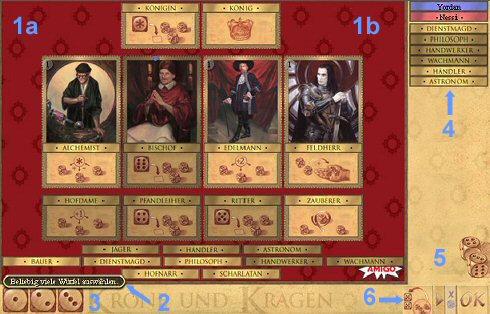
Central is the field of play with the designed court state. If you drive up or down with the mouse, a number of the farm state is shown in full size. If you move the mouse into the left half of the field (1a), the lower part of the maps Requirements for the acquisition of persons; is the mouse in the right half (1b), you see the Skills the courtesy.
At the bottom of the field, the action display (2) is on the left; here the action to be taken is always displayed.
Below the action display is the space for the cubes (3) already laid out.
On the right side, players are listed with all their previously acquired courts (4). In the current round already used persons are shown darker. If you run the mouse over the names of the players, their court people will be displayed. If you stay on a person with the mouse, the window appears with the skills of this person. If you stay on it, you also get the tool tip.
Below the player display is the place to dice (5). Here are the active cubes and here they can be influenced by the court state.
To perform and/or confirm your own actions, use the action field at the right bottom (6).
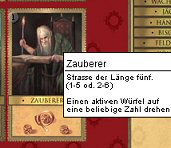
If you stay with the mouse over a card of the court state, one of the tool tip declares the name, the purchase condition and ability of the corresponding person.
The move
In each turn, one tries to improve his position at the Königshof by acquiring another personal card. Depending on the map, it is necessary to fulfill a certain condition with its cubes. You dice as often as you like, but after each throw at least one cube that you can no longer change in the course of the train. If you are in a row, you can use one or more of your cards at any time to get more cubes or exchange existing ones. However, each card may only once per round are used.
Game sequence
The starter starts the game by dice with its three dice. To do this, it clicks OK below.
In the later course, you can decide before the first litter whether you already want to use farm people (if you already have them) or rather want to dice.
Now you can either put dice out or use yard people to multiply the number of dice or to change the dice.
How to use
To use yards, simply click on them at the top right of the player's ad.

At the bottom right in the action field, the associated symbol appears with the properties of this person, here for example the service maid. If you have chosen a person with whose help you can change cubes, click on the desired cube(s) (they turn green) and change the cubes (depending on the person) with the small arrow keys. Then you confirm this action with OK. Now you can either play other cards or click the cubes you want to put out and confirm them with OK.

Both actions (use people and expose cubes) can be executed as desired in succession. You simply select the corresponding buttons.
Cubes
After each throw, at least one cube must be taken out. However, it is possible to change it beforehand by means of the court state. You dice until you put all the cubes aside.
Professionals
Once all the cubes have been laid out, you can now a Take a person from the court state whose conditions can be met with its cubes. The possible cards are shown brightly. You select one of them with a mouse click and confirm the choice with OK. That's the end of his train.
Warning: Not all courts are as often as possible in the game (see below). It can therefore quite happen that the desired person is no longer present.
Series
A game round is played clockwise. Once every player was on the line, the starter changes against clockwise. The last player in the previous round will be the new starter and is thus twice in a row.
Playing
Once a player has seven equal cubes, can he purchase the king (and thus also the queen). This will blow the end of the game. The running round is played normally to the end, then the final round starts. Here, too, the starter changes as described, but the owner of the king always dice last!
Final round
The goal of the final round is to acquire or acquire the king. defending him (the queen always remains with the original player). To do this, each player tries to throw as high as possible the more equal cubes the better. If the number is equal, the higher number of eyes decides. If this is also the same, the first thrown litter counts more.

The highest bid is always displayed with the corresponding player.
The player who first acquired the king has two advantages:
- His throw with which he acquired the king is the first commandment. This must be forbidden by any other player who wants to buy the king.
- in his final litter, it is enough for him to draw with the currently highest litter to conquer the king.
Who has the king in the end wins the game. The rest of the seats are based on the litters in the final round.
Court of Justice
Series 0
Court of Auditors
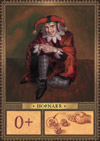
- Costs: The eye sum of the dice result Exceeding 0 i.e. the yard fools can be purchased with each litter.
- Ability: You may a throw active cubes again.
Sharlatan
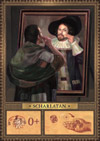
- Costs: The eye sum of the dice result Exceeding 0 be. In addition, you have to own the yard fools.
- Ability: At the beginning of the train you take a Dice additionally on the hand.
The Sharlatan replaces the court fool. In contrast to the other character cards, it is possible to purchase another court fool, if you have already transformed your court fool into a sharlatan.
Series I
Construction
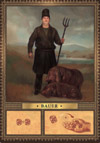
- Cost: You need two identical cubes in his dice result.
- Ability: At the beginning of the train you take a Dice additionally on the hand.
Service maid
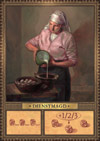
- Costs: All dice the dice result must be uneven Show numbers.
- Ability: You may a active cubes add one, two or three to the number of eyes. No more than 6.
Philosophy

- Costs: All dice the dice result must be straight ahead Show numbers.
- Ability: You can an active cube remove any number of eyes and another active cube add. No number of eyes less than 1 or greater than 6 may be produced.
Example: A player dice 5-3-1 and uses the philosopher by withdrawing from the 5 two and adding to the 1; he has 3-3-3.
Craftsmen
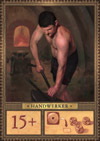
- Costs: The eye sum of the dice result Must be 15 or more.
- Ability: You can an additional Cubes as active cubes with number of eyes 1 to play.
Guardian
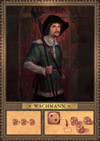
- Cost: You need three equal cubes in his dice result.
- Ability: You can an additional Cubes as active cubes with number of eyes 2 to play.
Series II
Hunters
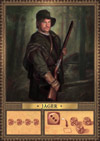
- Cost: You need four equal cubes in his dice result.
- Ability: You can an additional Cubes as active cubes with number of eyes 3 to play.
Dealers
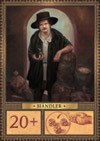
- Costs: The eye sum of the dice result Must be 20 or more.
- Ability: You can as many as possible throw active cubes again.
Astronomer
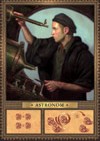
- Cost: You need two equal cubes in his dice result. Of course, four identical cubes are also possible.
- Ability: You can a turn active cubes to the number of a cube you have already set out.
Series III
Farm lady
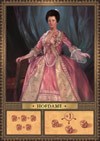
- Cost: You need three identical and two identical cubes in his dice result. Of course, five identical cubes are also possible.
- Ability: You can as many as possible active cubes one add to the number of eyes. No number of eyes greater than 6 may arise.
Pawn bonds
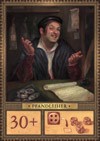
- Costs: The eye sum of the dice result must be 30 or more.
- Ability: You can an additional Cubes as active cubes with number of eyes 4 to play.
Knights
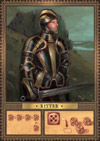
- Cost: You need five equal cubes in his dice result.
- Ability: You can an additional Cubes as active cubes with number of eyes 5 to play.
Magicians
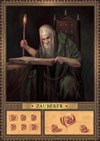
- Cost: One needs one Road of length five, i.e. the number of eyes 1-5 or 2-6 in its dice result.
- Skills: You can a active cubes on Number turn.
Series IV
alchemist
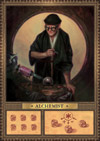
- Cost: One needs one Street of the length six, i.e. the number of eyes 1-6 in its dice result.
- Ability: You can move the number of eyes in three active cubes. No number of eyes less than 1 or greater than 6 may be produced. The sum of the three cubes must always remain the same.
Example: A player dice 6-2-1. He draws three from the 6 and adds one to the 2 and two to the 1.
Bishop
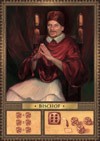
- Cost: You need three times two same cubes in his dice result. Of course, four identical and two identical and six identical cubes are also possible.
- Ability: You can an additional Cubes as active cubes with number of eyes 6 to play.
Edelmann
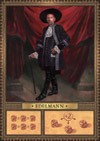
- Cost: You need two times three identical cubes in his dice result. Of course, six identical cubes are also possible.
- Ability: You can as many as possible active cubes two add to the number of eyes. No number of eyes greater than 6 may arise.
Fieldlor
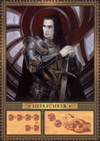
- Cost: You need six identical cubes in his dice result.
- Skills: At the beginning of the course must: man two take additional cubes on hand.
Series V
Queen
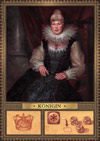
- Costs: The first player to acquire the royal card will also receive the Queen.
- Ability: You can an additional Cubes as active cubes with any Put your eye number into play.
King
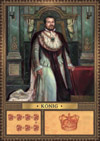
- Cost: You need seven equal cubes in his dice result.
- Ability: The player who first enjoys the king's favor gets the king and the queen. He's cutting the end of the game.
Distribution of cards
Depending on the number of players, the courts are often in the game:
| Courtesy | Number | |||
|---|---|---|---|---|
| 2 | 3 | 4 | 5 | |
| Series V (King, King) | 1 | 1 | 1 | 1 |
| Series IV (Alchemist, Bischof, Edelmann, Feldherr) | 1 | 2 | 2 | 3 |
| Series III (Hofdame, Pfandleiher, Ritter, Zauberer) | 1 | 2 | 2 | 3 |
| Series II (Jäger, Distributor, Astronomer) | 1 | 2 | 3 | 3 |
| Series I (Bauer, Dienstmagd, Philosopher, Craftsman, Wachmann) | 2 | 2 | 3 | 4 |
| Series 0 (Hofnarr, Scharlatan) | 2 | 3 | 4 | 5 |
tactics tips
- You should be careful to buy enough cards to use additional cubes otherwise you can vary wonderfully in the end, but you simply have too little dice to win with it.
- The right timing is important: it is often of great importance when and in what order you use your cards.
Here's a little Example to illustrate:
A player has the peasant, the craftsman, the nobleman and the astronomer on his hand. Through the peasant he starts with an additional cube and dice 1-3-3-6. He uses the craftsman to put another one. He then uses the nobleman and makes two threes from the two ones. Now he has 3-3-3-3-6. He's putting out the four threesomes and then he's still using his astronomer to turn the six into a threesome. Now he has 3-3-3-3-3 and can take the knight.

